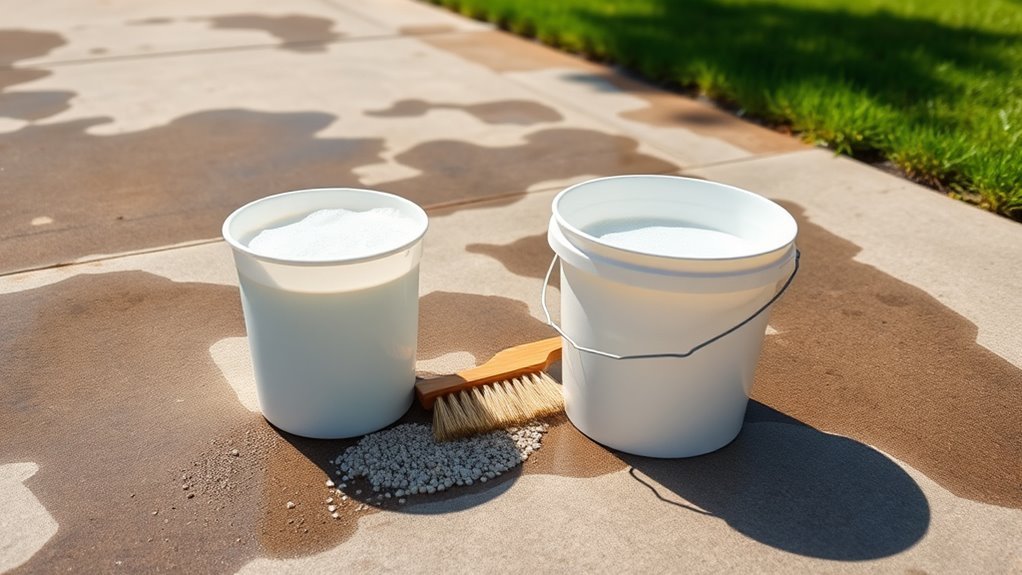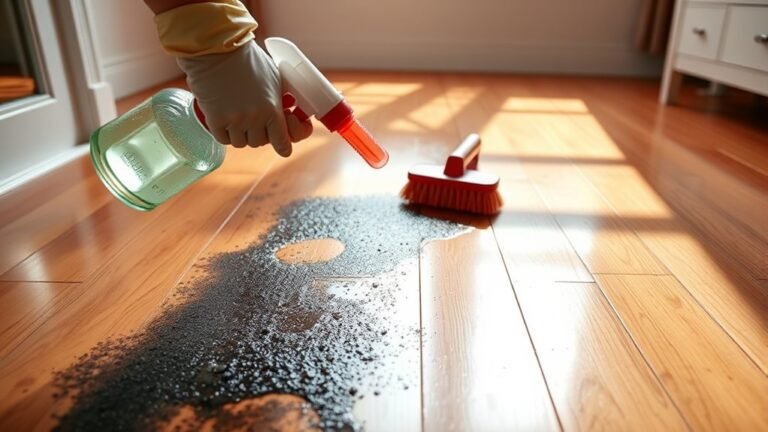Cleaning Your Driveway: Oil Stain Removal Tips
If you’ve got oil stains on your driveway, start by identifying the type and age of the stain. Fresh spills respond well to baking soda sprinkled on top to absorb oil, followed by scrubbing with dish soap and warm water. For tougher stains, kitty litter can soak up excess oil before you use a commercial degreaser. Use a pressure washer carefully to rinse the area without damaging surfaces. Keep going for more tips on prevention and eco-friendly cleaning options.
Identifying Different Types of Oil Stains
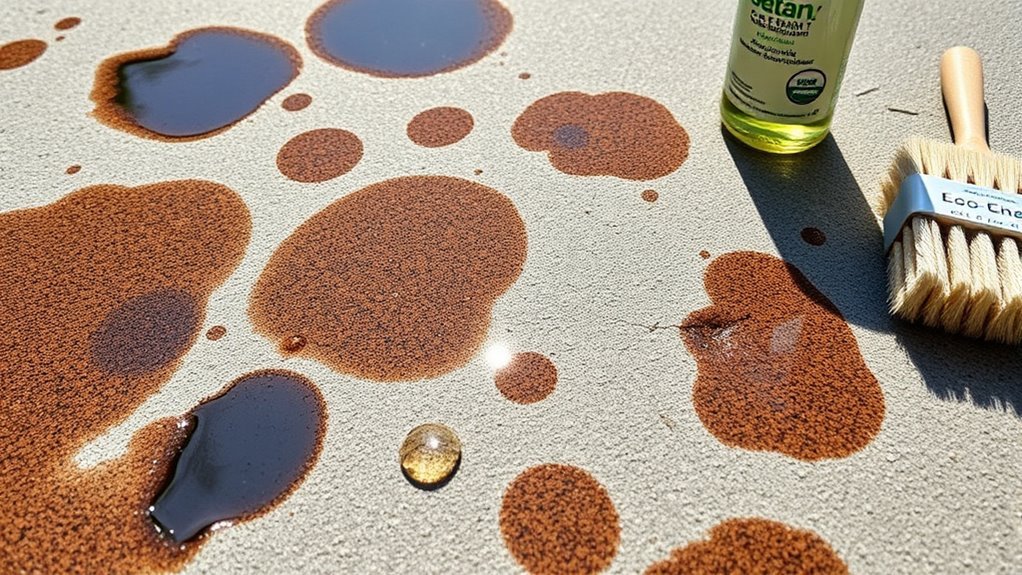
Before you can effectively remove oil stains, you need to identify what type you’re dealing with. Spotting the differences starts with identifying stain colors—fresh oil often appears dark, almost black, while older stains may fade to a brownish hue. Understanding stain sources helps too; motor oil, grease, and cooking oil each leave distinct marks and textures. Recognizing these details lets you choose the best removal method, freeing you from guesswork. By knowing exactly what caused the stain, you’re not just cleaning—you’re reclaiming your space. So, take a moment to observe the stain’s color and consider where it came from. This simple step empowers you to tackle the mess head-on and regain control of your driveway’s appearance.
Essential Tools and Materials Needed
Now that you’ve identified the type of oil stain you’re dealing with, gathering the right tools and materials will make the removal process much smoother. You’ll want to have essential cleaning supplies like absorbent materials—kitty litter or sawdust work well—to soak up fresh spills. A sturdy brush with stiff bristles helps you scrub stubborn stains effectively. Don’t forget gloves to protect your hands and a bucket for mixing cleaning solutions. For driveway maintenance, degreasers or specialized oil stain removers are key to breaking down tough residues. Having a hose or pressure washer ready will help rinse everything clean afterward. By equipping yourself with these tools, you’re set to tackle oil stains confidently, keeping your driveway looking fresh and free from unsightly marks.
Preparing the Driveway for Cleaning
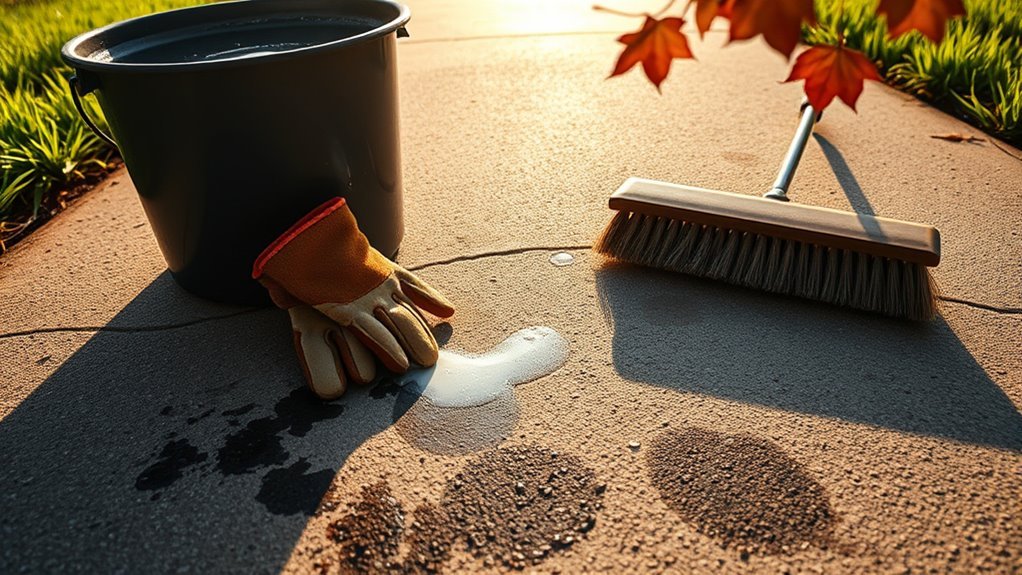
Although it might seem straightforward, preparing your driveway properly is crucial for effective oil stain removal. Start with a thorough driveway inspection to identify all oil spots, dirt, and debris. This step helps you pinpoint problem areas so you can focus your efforts where it counts. Next, clear the surface by sweeping away loose dirt, leaves, and gravel. This surface preparation guarantees that cleaning agents directly target the stains without interference. If your driveway has cracks or uneven areas, note them for extra care during cleaning. Taking these simple steps gives you control over the process, making stain removal more efficient and less frustrating. Proper preparation sets you free from wasted time and effort, letting you enjoy a cleaner, more inviting driveway faster.
Using Baking Soda and Dish Soap for Fresh Stains
With your driveway prepped and ready, tackling fresh oil stains becomes much easier. Start by sprinkling baking soda generously over the stain—one of the best baking soda uses is its ability to absorb grease without harsh chemicals. Let it sit for about 10 minutes to lift the oil from the surface. Next, mix a few drops of dish soap with warm water; dish soap effectiveness lies in its grease-cutting power, making it perfect for breaking down fresh oil. Scrub the area gently with a stiff brush, working the soap and baking soda into the stain. Rinse thoroughly with water, and you’ll see the stain fading away. This simple combo gives you freedom from tough stains using everyday items, no fancy products needed.
Applying Cat Litter for Oil Absorption
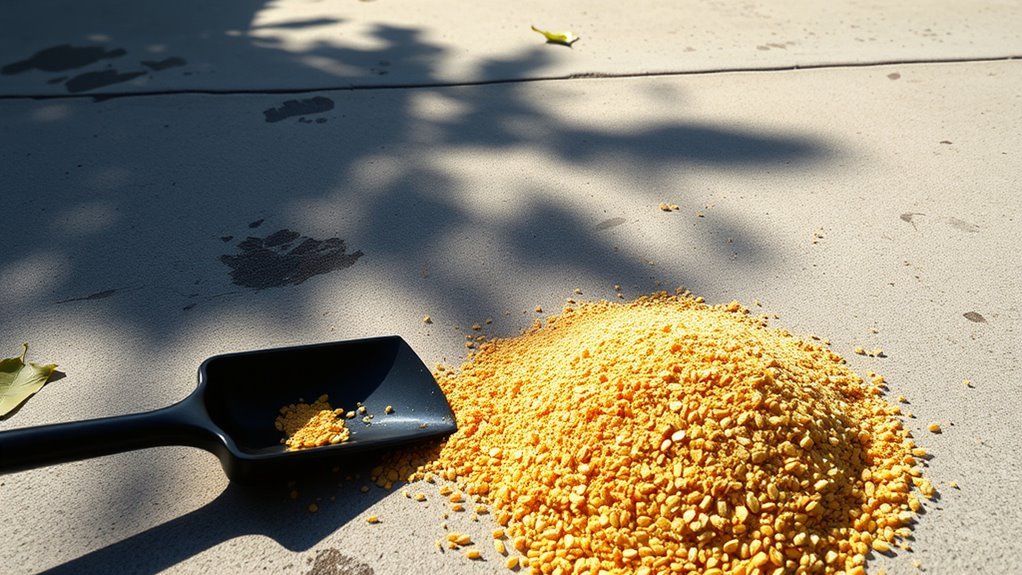
When tackling oil stains, picking the right cat litter can make a big difference in absorption. You’ll want to spread a generous layer over the stain and let it sit long enough to soak up the oil. Afterward, sweeping up and disposing of the litter properly will help keep your surface clean and stain-free.
Choosing the Right Litter
If you want to effectively soak up oil stains, choosing the right cat litter is essential. Not all litter types work the same—clumping litters may trap moisture but aren’t as good at absorbing oil. Instead, go for clay-based or silica gel litters, as their porous structure enhances litter effectiveness in soaking up grease and oil. Avoid scented litters or those with additives since they won’t improve absorption and could complicate cleanup. By selecting a high-quality, oil-absorbent litter, you’re giving yourself more control over the stain removal process. This choice means less scrubbing and more freedom from stubborn marks on your driveway. Make sure to pick litter that aligns with your goals for fast, efficient, and hassle-free oil stain absorption.
Application and Cleanup Tips
Although choosing the right cat litter is important, how you apply and clean it up makes all the difference in removing oil stains effectively. Start by spreading a generous layer of cat litter directly onto the fresh oil spot, covering it completely. Let it sit for at least an hour to absorb the oil; for tougher stains, overnight works best. When it’s time to clean up, sweep the litter carefully to avoid spreading the stain. Dispose of the used litter properly to keep your driveway maintenance eco-friendly. For stubborn spots, repeat the process or combine with a mild detergent. This simple method frees you from harsh chemicals and keeps your driveway looking clean, enhancing stain prevention and maintaining your freedom to enjoy your outdoor space without worries.
Cleaning With Commercial Degreasers
When tackling oil stains, choosing the right commercial degreaser can make all the difference. You’ll want to follow proper application techniques to guarantee the stain breaks down effectively. Also, don’t forget to take safety precautions to protect yourself and your surfaces during cleaning.
Choosing Effective Degreasers
Because oil stains can be stubborn, choosing the right degreaser is key to effective removal. You’ll find various degreaser types on the market—solvent-based, citrus-based, and enzyme-based—each offering unique strengths. Solvent-based degreasers power through heavy, set-in stains but can be harsh. Citrus-based options provide a natural, less toxic alternative, perfect if you value eco-friendliness. Enzyme-based products break down oil gradually, ideal for ongoing maintenance. When comparing products, look for concentration, ease of use, and environmental impact. Reading product comparisons helps you pick one that matches your freedom-loving lifestyle—effective without unnecessary chemicals or hassle. Choosing wisely means you’re not just cleaning your driveway; you’re reclaiming your space with confidence and care.
Application Techniques
Before you start applying commercial degreasers, it’s important to prepare the stained area properly to maximize effectiveness. Begin by clearing debris and lightly wetting the spot to loosen the oil. When it comes to application methods, you’ve got options: spraying, pouring, or brushing on the degreaser. Choose the method that suits your stain size and location best. For stubborn spots, applying the degreaser and letting it sit for 10-15 minutes enhances stain treatment. Afterward, scrub gently with a stiff brush to break down the oil further. Finally, rinse thoroughly with water to wash away residue. By following these steps, you maintain control over your driveway’s cleanliness and enjoy a more liberated, fresh space without the hassle of persistent stains.
Safety Precautions
Although commercial degreasers are effective for removing oil stains, you’ll need to handle them carefully to protect yourself and your surroundings. First, always wear appropriate safety gear—gloves, goggles, and a mask—to shield your skin, eyes, and lungs from chemical hazards. These products can be harsh, and direct contact or inhalation can cause irritation or worse. Work in a well-ventilated area to reduce fumes and avoid breathing in toxic vapors. Keep degreasers away from children, pets, and plants to prevent accidental exposure. Store chemicals securely and dispose of any waste responsibly. By respecting these safety precautions, you maintain your freedom to clean effectively without risking your health or harming the environment. Safety isn’t a restriction; it’s the key to doing the job right.
Utilizing Pressure Washers Safely
When you use a pressure washer to tackle oil stains, it’s important to handle the equipment carefully to avoid damage or injury. Following pressure washer safety tips guarantees you clean effectively without risking harm to yourself or your driveway. Regular equipment maintenance keeps your washer running smoothly and extends its life. Keep your freedom intact by mastering safe, efficient cleaning.
| Pressure Washer Safety Tips | Equipment Maintenance Tasks |
|---|---|
| Wear protective gear | Check hoses for leaks |
| Keep a firm grip on the wand | Clean nozzles regularly |
| Avoid pointing at people | Inspect power cords |
| Use correct pressure settings | Store in dry, safe place |
Stick to these guidelines to enjoy a clean driveway and lasting equipment.
Preventative Measures to Avoid Future Stains
To keep your driveway looking clean longer, it helps to take simple preventative steps that reduce the chances of new oil stains forming. You want freedom from constant cleaning, so consider these key actions:
- Apply preventative sealing to create a protective barrier that repels oil and fluids.
- Perform regular maintenance by inspecting and cleaning spills immediately before they set.
- Use drip pans or mats under vehicles prone to leaks to catch oil before it hits the driveway.
- Park in shaded or covered areas to minimize heat-related damage that can worsen stains.
Natural Alternatives for Eco-Friendly Cleaning
If you’re looking to clean oil stains without harsh chemicals, natural alternatives offer effective and eco-friendly solutions. You can rely on simple, eco friendly products like baking soda, vinegar, and lemon juice to break down grease without harming the environment. For tougher stains, a paste made from baking soda and water works wonders—it lifts oil while being gentle on surfaces. Using these sustainable cleaning methods not only protects your driveway but also reduces your carbon footprint. Plus, you avoid exposure to toxic substances, giving you peace of mind. Embracing natural cleaners lets you maintain a spotless driveway while staying true to your values of freedom and responsibility. It’s a smart, safe way to keep your space clean and green without sacrificing effectiveness.
Tips for Maintaining a Spotless Driveway Year-Round
Although oil stains can be stubborn, you can keep your driveway spotless all year by adopting a few simple habits. Consistent driveway maintenance and seasonal cleaning are key to enjoying a clean, free space. Here’s how you can stay on top of it:
- Sweep regularly – Remove dirt and debris before they settle.
- Address spills immediately – Don’t let oil soak in; blot and treat stains fast.
- Use eco-friendly cleaners seasonally – Deep clean with natural solutions to protect your driveway and the environment.
- Inspect and seal cracks annually – Prevent stains and damage by sealing your driveway before harsh weather.
Häufig gestellte Fragen
Can Oil Stains Damage the Concrete Structure of My Driveway?
Yes, oil stains can damage the concrete structure of your driveway over time. When oil seeps in, it can weaken the surface, causing cracks and deterioration. To keep your driveway strong and lasting, focus on oil stain prevention and regular concrete maintenance. You don’t want to be stuck dealing with costly repairs later. Taking simple steps now lets you enjoy your space freely without worrying about hidden damage beneath your feet.
How Long Does It Take for Oil Stains to Set Permanently?
Oil stain duration can vary, but if you don’t act quickly, those stains can set permanently within just a few hours to a couple of days. To keep your driveway looking fresh and avoid stubborn marks, stain prevention is key—you’ll want to clean spills immediately. Don’t let oil soak in and ruin your freedom to enjoy a clean, inviting space. Quick action means you stay in control of your driveway’s appearance!
Are There Specific Oil Types That Are Harder to Remove?
You’ll find some oils tougher to clean up than others. Motor oil, for example, tends to seep deeper and stick strongly to surfaces, making it harder to remove. Vegetable oil, on the other hand, is usually lighter and easier to lift away with the right cleaner. Knowing which oil you’re dealing with gives you that freedom to pick the best method and tackle stains without frustration. Don’t let stubborn spots limit your driveway’s look!
Can I Use Bleach to Remove Oil Stains Effectively?
You might be tempted to use bleach to tackle oil stains, but it’s not the best choice—it can damage your driveway and harm nearby plants. Instead, consider bleach alternatives like baking soda or specialized driveway cleaners; they’re safer and just as effective. For long-term driveway maintenance, regular cleaning and prompt stain treatment will keep your space looking fresh without harsh chemicals. This way, you maintain freedom from tough stains and preserve your driveway’s integrity.
What Should I Do if the Stain Persists After Cleaning?
What’s your next move when a stubborn stain just won’t budge? If the stain persists after cleaning, don’t stress—you’ve still got options. Consider applying a stronger cleaner or repeating the process, but if it’s really tough, why not call in professional services? They can guarantee thorough removal and help with stain prevention moving forward. That way, you keep your driveway looking fresh without sacrificing your freedom to enjoy your space.
